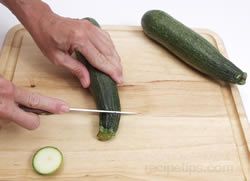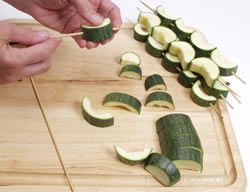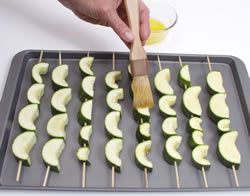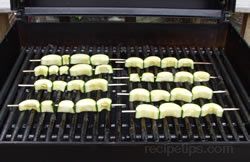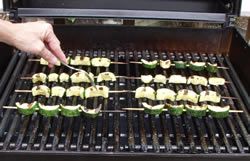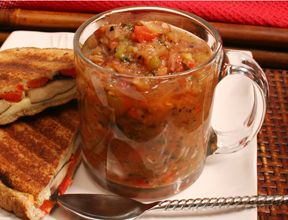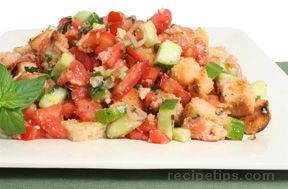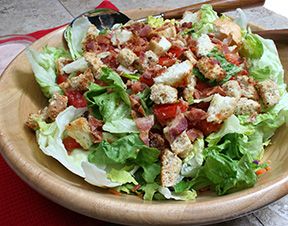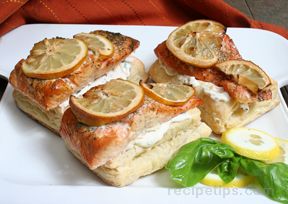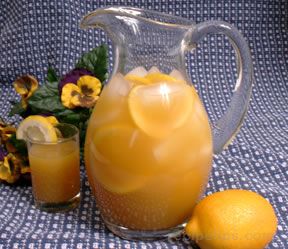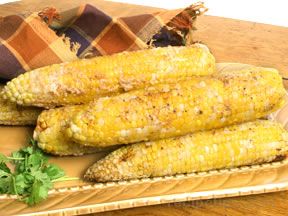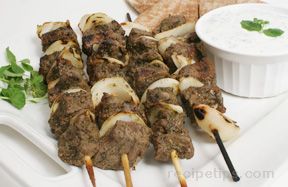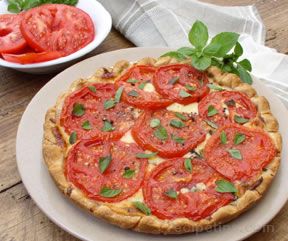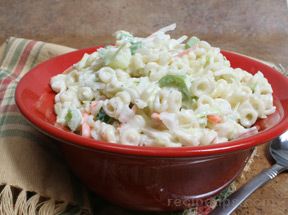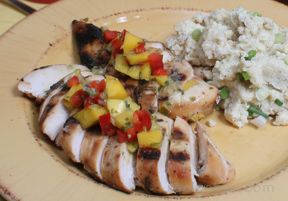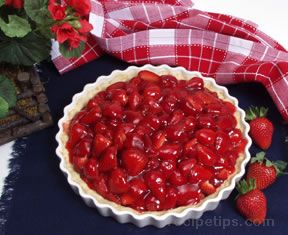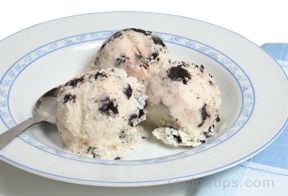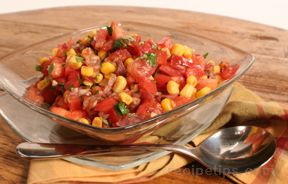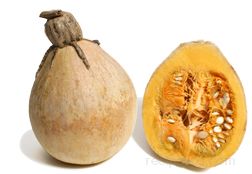|
Summer Squash Preparation | Summer Squash Cooking | Tips
| Summer Squash |
|
   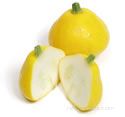
Squash: The fruits of various members of the gourd family, which fall into two classifications, summer squash and winter squash.
Summer squash are a soft-shelled variety with thin edible skins and edible seeds. It has a tender flesh that requires only a short cooking time. They are very low in calories, high in vitamin C and high in fiber. Summer squash are picked immature while they are still tender and are generally eaten within a short period of time since they are very perishable. Summer squash can be prepared in several ways, such as steamed, baked, sautéed and deep-fat fried. Common varieties of summer squash include zucchini, pattypan and crookneck. |
| Uses:
Summer squash can be eaten raw on its own, as an appetizer, in salads, or on sandwiches. Some summer squash, such as zucchini, can be grated and added to breads, cakes and muffins. Summer squash can also be added to other vegetables, stews, casseroles, and soups. They can also have stuffing added to them and then baked. |
| How to Buy:
Select squash that have a shiny, bright colored skin, are heavy for their size, firm, and free of rust spots, bruises, and cracks. Avoid squash with a dull appearance, which is an indication that it is not fresh. Do not select squashes that are overly large because they tend to be fibrous and their flavor can be bitter. Too small of squash will lack flavor. |
|
At Their Best:
Summer squash are picked immature while they are still tender and are generally eaten within a short period of time since it is very perishable. In some areas, summer squash is available year round but their peak time is early summer to late summer. |
|
Storage:
Handle summer squash with care because they are damaged very easily. They can be stored for four to five days if placed in a perforated plastic bag and placed in the refrigerator. Do not wash until ready to use. |
| Varieties: |
|
Zucchini

Mature Green Zucchini

Flowered or Baby Zucchini
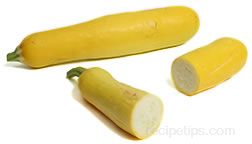
Yellow Zucchini
|
Probably the most well-known variety of summer squash. It has dark green or yellow skin covering an off-white flesh. The skin often contains some lighter colored specs or stripes. It is much like a cucumber in size and shape. They are harvested at 7 to 8 inches long, when they are the most flavorful. Large zucchini lose their tenderness and are much less flavorful than the smaller, younger zucchini. Zucchini can be steamed, fried, sautéed, or baked and they are excellent when sliced and grilled. Also referred to as a courgette. |
|
Pattypan Squash
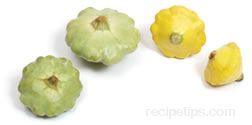
|
A round flat summer squash that has scalloped edges and is light green, white or yellow in color. The pale green variety turns to white in color if allowed to mature longer. This variety is harvested when it is 3 days to a week old, so the skin, white flesh, and seeds remain tender and edible. Pattypan squash are usually available in sizes ranging from over 1 inch to 4 inches in diameter. The smaller squash are often steamed or braised and served as part of a vegetable dish, providing a slightly sweet, nutty flavor. When they are larger, the top can be sliced off, the flesh scooped out, and the remaining section becomes a bowl that can be stuffed with various meats, vegetables, onions, cheese, or other ingredients and baked. |
|
Crookneck Squash
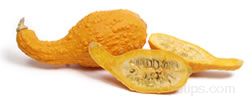
|
A type of summer squash that has a bulbous rounded shape at the bottom with a tapering curved neck at the top or vine end. This vegetable is light yellow with slightly bumpy skin when young, turning to deep yellow and more bumpy as it matures. It has a pale meaty flesh that when cooked or eaten raw, provides a slightly sweet flavor. Crookneck squash will be 8 to 10 inches long but are best if picked when they are young at about 6 inches long. A crookneck squash can be used in soups, stew, and side dishes with a variety of choices for serving it raw, baked, steamed, broiled, or sautéed. Fresh crookneck squash can be stored in the refrigerator for only about four days or frozen if kept for a longer period of time. |
Sunburst Squash
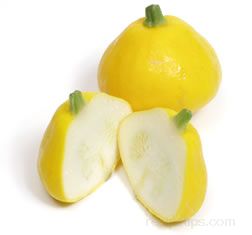 |
A very small acorn shaped summer squash that has a smooth outer skin accented with a scalloped edging around the middle outside of the squash. When steamed, sautéed or boiled, the flesh provides a delicately mild flavor. This squash is often used as an appetizer with dip, or as an ingredient to be added to salads, soups and stews. |
Yellow Squash
 |
A type of summer squash that comes in crookneck and straightneck varieties. It is much like a zucchini in shape, flavor, and texture, except that the color is yellow. Younger squash have the best flavor and are a bit sweeter than large, overripe squash. |
|
Chayote Squash

|
A mild flavored, pear-shaped squash, similar to zucchini in flavor, which is grown in Florida, California, Mexico, and the Caribbean. It has a pale green, creased rind and a single soft seed in the center. The chayote's pleasant, mild flavor makes it a versatile vegetable that can be boiled, fried, sautéed, added to soups, stuffed or served as a salad. They are also called Mirlitons. Chayotes are available all year round, but the best time for them is September through December. When selecting, choose those that are about 6 inches long and weigh no more than 4 ounces, with smooth skins that do not have blemishes or soft spots. They will keep 3 to 4 days when wrapped in plastic and stored in the vegetable drawer of the refrigerator. |
|
Opo Squash
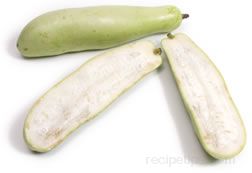
|
A long narrow variety of squash very similar to zucchini that is often considered to be an Asian squash since it originated in Asia. The outer skin can range in color from yellow to green while the inner flesh, which contains seeds, is firm textured and white in color. When young, the squash has a mild flavor, but as it matures the taste becomes increasingly bitter. It is a good squash for sautéing, stir-frying, or as an ingredient for soups and stews. It can be kept refrigerated for approximately 1 week. This squash is also known as Bottle Gourd, Hu Lu Gua, Long Melon, Long Squash, Peh Poh, and Woo Lo Kua. |
Summer Squash Preparation
Summer squash should not be washed until you are ready to use it. Because of its soft skin, the summer squash does not need to be peeled. Before cooking the squash, prepare the squash as instructed below.
Draining Squash
Summer squash has a high water content and will sometimes need to be drained, otherwise the dish you are preparing may become too watery. Drain the squash by cutting it into slices, arranging them in a shallow dish, and sprinkling with salt. After 20 to 30 minutes, rinse the slices under cold running water and pat dry.
Summer Squash Cooking
Boiling
Boiling is not recommended because of the tendency of the squash to become watery and lose much of its flavor. If boiling is the method chosen, use one of the following processes.
Whole Uncut Squash: Use as little water possible to boil an uncut, unpeeled squash. Poke holes into skin, and boil covered for up to 1 hour. Boil just until tender when poked with a fork.
Cubed Squash: Leave squash unpeeled and cut into 3/4 inch cubes. Place in a pan with very little water and cook for approximately 10 minutes. Cook until just tender.
Baking
- Cut squash in half, remove seeds. The skin should remain on the squash.
- Add a bit of butter to open cavity of each half.
- Place the squash cavity side up in a baking dish with 1 inch of water.
- Bake for 20 minutes to 1 hour, until desired tenderness.
Steaming
Steaming is a good method to use for cooking summer squash.
- Cut the squash in half and remove seeds.
- Cut squash to the desired size and then place them on the steam rack in a saucepan.
- Steam until tender, which will generally take 20 to 45 minutes. The amount of time will vary depending on the quantity and size of pieces being steamed.
Microwaving
- Cut squash in half, remove seeds.
- Place squash cavity down on a microwave safe plate.
- Poke skin once or twice to allow some steam to escape.
- Cover with damp paper towel. Microwave on high for 5 to 20 minutes, until desired tenderness.
Grilling
Tips
- Cut raw summer squash into slices and add to salads in the same manner as cucumbers.
- Julienned pieces of summer squash are good served with vegetable dips.
- To remove some of the moisture from the squash before cooking, sprinkle the raw flesh with salt, place cavity side down on a couple of layers of paper towels and allow to stand for 20 to 30 minutes. The salt will draw the moisture out and the paper towel will absorb it. Rinse with cold water before cooking.
- When cooking summer squash, select cooking methods, such as baking and grilling, that will evaporate some of the moisture in the squash. This will produce a dryer squash when cooked.
- Add a little brown sugar, honey or maple syrup to the squash when cooking to produce a sweeter tasting squash.
|




















